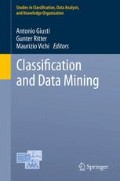Abstract
In this paper, we introduce a new clustering strategy for temporally ordered data streams, which is able to discover groups of homogeneous streams performing a single pass on data. It is a two steps approach where an on-line algorithm computes statistics about the dissimilarities among data and then, an off-line algorithm computes the final partition of the streams. The effectiveness of the proposal is evaluated through tests on real data.
Access this chapter
Tax calculation will be finalised at checkout
Purchases are for personal use only
References
Balzanella, A., Lechevallier, Y., & Verde, R. (2011). Clustering multiple data streams. In S. Ingrassia, R. Rocci, & M. Vichi (Eds.), New perspectives in statistical modeling and data analysis. Berlin: Springer.
Beringer, J., & Hullermeier, E. (2006). Online clustering of parallel data streams. Data and Knowledge Engineering, 58(2), 180–204.
Dai, B.-R., Huang, J.-W., Yeh, M.-Y., & Chen, M.-S. (2006). Adaptive clustering for multiple evolving streams. IEEE Transactions on Knowledge and Data Engineering, 18(9), 1166–1180.
De Carvalho, F., Lechevallier, Y., & Verde, R. (2004). Clustering methods in symbolic data analysis. In D. Banks, et al. (Eds.), Classification, clustering, and data mining applications (Studies in classification, data analysis, and knowledge organization, pp. 299–317). Berlin: Springer.
Diday, E. (1971). La methode des Nuees dynamiques. Revue de Statistique Appliquee, 19(2), 19–34.
Diday, E., & Noirhomme-Fraiture, M. (2008). Symbolic data analysis and the SODAS software. Chichester/Hoboken: Wiley.
Ganguly, A. R., Gama, J., Omitaomu, O. A., Gaber, M. M., & Vatsavai, R. R. (2009). Knowledge discovery from sensor data. Boca Raton: CRC.
Kavitha, V., & Punithavalli, M. (2010). Clustering time series data stream – A literature survey. International Journal of Computer Science and Information Security, 8(1), 289–294.
Liao, T. W. (2005). Clustering of time series data. A survey. Pattern Recognition, 38(11), 1857–1874.
Maulik, U., & Bandyopadhyay, S. (2002). Performance evaluation of some clustering algorithms and validity indices. IEEE Transactions on Pattern Analysis and Machine Intelligence, 24(12), 1650–1654.
Rodriguess, P. P., & Pedroso, J. P. (2008). Hierarchical clustering of time series data streams. IEEE Transactions on Knowledge and Data Engineering, 20(5), 615–627.
Author information
Authors and Affiliations
Corresponding author
Editor information
Editors and Affiliations
Rights and permissions
Copyright information
© 2013 Springer-Verlag Berlin Heidelberg
About this paper
Cite this paper
Balzanella, A., Lechevallier, Y., Verde, R. (2013). Clustering Data Streams by On-Line Proximity Updating. In: Giusti, A., Ritter, G., Vichi, M. (eds) Classification and Data Mining. Studies in Classification, Data Analysis, and Knowledge Organization. Springer, Berlin, Heidelberg. https://doi.org/10.1007/978-3-642-28894-4_12
Download citation
DOI: https://doi.org/10.1007/978-3-642-28894-4_12
Published:
Publisher Name: Springer, Berlin, Heidelberg
Print ISBN: 978-3-642-28893-7
Online ISBN: 978-3-642-28894-4
eBook Packages: Mathematics and StatisticsMathematics and Statistics (R0)

